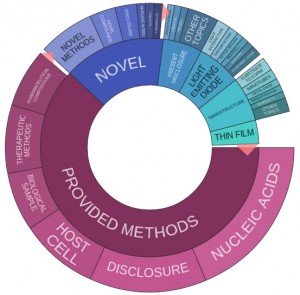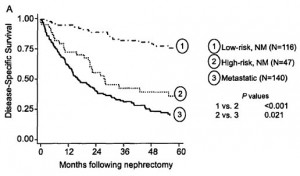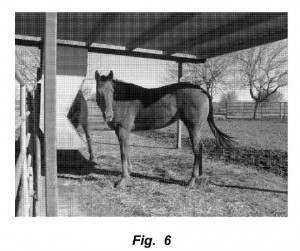The University of California is a public university system comprised of 10 campuses boasting a current enrollment level of 238,700 students, including both the graduate and undergraduate levels, and about 1.6 million alumni.
An average of five inventions per day are developed at the various research facilities sponsored by the University of California, as of this January. R&D spending at UC reached $4.4 billion over the past year, with $2.95 billion of that total paid for by federal sources; the university system receives more funding from the National Institutes of Health and the National Science Foundation than any other institution. This funding goes to support R&D activities at facilities like the University of California Center for Accelerated Innovation, which coordinates research activities into heart, lung and blood diseases.
Interestingly, UC has kept up a rapid pace of innovation despite suffering from reduced funding levels. Between 2012 and 2013, federal research awards to the university system dropped to early 2000s funding levels when adjusting for inflation, owing at least somewhat to the federal sequester of March 2013. State government investment in the public university system’s R&D is relatively small. In 2011, California’s government invested $149 million into UC research and development.
 In preparation of the Association of University Technology Managers meeting that will take place in New Orleans from February 22nd through the 25th, we’ll be profiling the innovations of a few research institutions, starting with the University of California.
In preparation of the Association of University Technology Managers meeting that will take place in New Orleans from February 22nd through the 25th, we’ll be profiling the innovations of a few research institutions, starting with the University of California.
The UC January 2015 fact sheet linked above and here reports that the public university system maintains a portfolio of 11,556 active patent grants. Patented technologies which are currently available for licensing through UC include laser scanners for eye tracking, cardiovascular disorder treatments and environmentally friendly water treatment techniques. In 2013, the Regents of the University of California were issued 399 patents by the U.S. Patent and Trademark Office, tied for 89th-most with the U.S. Navy and LSI Corporation of San Jose, CA. As the Innography visualization to the right shows us, a great percentage of UC’s 2014 inventions were related to providing methods involving nucleic acids, host cells and pharmaceutical compositions.
[Bio-Pharma]
The University of California’s Issued Patents: Medical Treatments and Systems for Cancer, Alzheimer’s Disease
In our search of UC’s latest patents, we noted a tremendous focus on medical innovations, especially those designed to treat various forms of cancer. Treatment methods for renal cell carcinoma are the focus of U.S. Patent No. 8936914, entitled Methods of Renal Cell Carcinoma Prognosis and Treatment Selection With Carbonic Anhydrase IX. The patent protects a method of providing a  prognosis for survival of a patient diagnosed with metastatic renal cell carcinoma by obtaining a sample of a renal tumor or metastatic lesion and detecting the expression of a carbonic anhydrase IX (CAIX) protein through immunohistochemical staining or immunoassay using a CAIX-binding antibody. This system is designed to yield prognostic information for kidney cancer patients by quantifying CAIX, a molecular marker for kidney cancer. The patent application for this patent was originally filed in April 2003 after which time it faced three final rejections, the latest of which in April 2014 cited claim rejections under Section 101 of U.S. patent code for the unpatentable natural principle of the correlation between CAIX, malignant potential and likelihood of survival. Other claims were also rejected under Section 103 for obviousness and under Section 112 for specification. Other techniques for determining the metastatic potential of cancer cells are disclosed and protected by U.S. Patent No. 8935098, which is titled Method and Device for High Throughput Cell Deformability Measurements. The patent claims a system for measuring a morphological parameter of a cell that includes a substrate with multiple microfluidic channels to carry cells, an extensional region for intersecting two microfluidic channels, a pump flowing cells into at least one microfluidic channel, a focusing region in at least one channel for focusing cells into a stream of cells and an imaging device for taking pictures of cells passing through the extensional region. This invention is intended to provide practical biomechanical biomarkers for measuring cell deformability while increasing the rate at which cells can be properly analyzed from one cell per minute to 1,000 per minute.
prognosis for survival of a patient diagnosed with metastatic renal cell carcinoma by obtaining a sample of a renal tumor or metastatic lesion and detecting the expression of a carbonic anhydrase IX (CAIX) protein through immunohistochemical staining or immunoassay using a CAIX-binding antibody. This system is designed to yield prognostic information for kidney cancer patients by quantifying CAIX, a molecular marker for kidney cancer. The patent application for this patent was originally filed in April 2003 after which time it faced three final rejections, the latest of which in April 2014 cited claim rejections under Section 101 of U.S. patent code for the unpatentable natural principle of the correlation between CAIX, malignant potential and likelihood of survival. Other claims were also rejected under Section 103 for obviousness and under Section 112 for specification. Other techniques for determining the metastatic potential of cancer cells are disclosed and protected by U.S. Patent No. 8935098, which is titled Method and Device for High Throughput Cell Deformability Measurements. The patent claims a system for measuring a morphological parameter of a cell that includes a substrate with multiple microfluidic channels to carry cells, an extensional region for intersecting two microfluidic channels, a pump flowing cells into at least one microfluidic channel, a focusing region in at least one channel for focusing cells into a stream of cells and an imaging device for taking pictures of cells passing through the extensional region. This invention is intended to provide practical biomechanical biomarkers for measuring cell deformability while increasing the rate at which cells can be properly analyzed from one cell per minute to 1,000 per minute.
 The prevention of parasitic disease which can be transmitted by insects is the goal of a few other patents we explored today. A repellant for disease carrying tsetse flies or eye gnats is described by U.S. Patent No. 8945595, issued under the title Insect Repellent and Attractants. The composition for disruption of insect host-seeking behavior protected here includes an aldehyde, an alcohol and a diketone in a formulation that disrupts an insect’s response to carbon dioxide for host-seeking behavior. The composition, which may be applied as a lotion, spray or dust, is capable of repelling mosquitoes and flies or modifying their CO2 homing ability. Treatments for diseases transmitted by tsetse flies are protected by U.S. Patent No. 8946455, which is titled Semi-Synthetic Small Molecules for the Treatment Parasitic Disease. The patent claims a compound that has endoperoxide activity. The endoperoxide treatment for Human African trypanosomiasis, also known as sleeping sickness, is derived from liquid fungal cultures and was developed to serve as a treatment for second stage infection of the central nervous system.
The prevention of parasitic disease which can be transmitted by insects is the goal of a few other patents we explored today. A repellant for disease carrying tsetse flies or eye gnats is described by U.S. Patent No. 8945595, issued under the title Insect Repellent and Attractants. The composition for disruption of insect host-seeking behavior protected here includes an aldehyde, an alcohol and a diketone in a formulation that disrupts an insect’s response to carbon dioxide for host-seeking behavior. The composition, which may be applied as a lotion, spray or dust, is capable of repelling mosquitoes and flies or modifying their CO2 homing ability. Treatments for diseases transmitted by tsetse flies are protected by U.S. Patent No. 8946455, which is titled Semi-Synthetic Small Molecules for the Treatment Parasitic Disease. The patent claims a compound that has endoperoxide activity. The endoperoxide treatment for Human African trypanosomiasis, also known as sleeping sickness, is derived from liquid fungal cultures and was developed to serve as a treatment for second stage infection of the central nervous system.
Techniques for treating diseases of the eye, especially those which could cause irreversible vision loss, are outlined by U.S. Patent No. 8945602, entitled Porous Photonic Crystals for Drug Delivery to the Eye. The method for treating an intraocular disease of the eye, which is claimed here, involves administering a porous silicon dioxide particle, the pores containing a drug for the treatment of the intraocular disease. This method of treating diseases such as age-related macular degeneration or nonspecific uveitis while addressing shortcomings of prior treatment methods involving eye drops or intravitreal injection.
The world still lacks an effective treatment technique to cure Alzheimer’s disease but the University of California may have made some steps in that direction with the invention discussed within U.S. Patent No. 8945858, titled Methods and Compositions for Treating Neurodegenerative Disorders and Alzheimer’s Disease and Improving Normal Memory. This innovation is intended to inhibit the production of beta-amyloid so as to prevent mutations in beta-amyloid precursor proteins (?APP) that might be the cause of Alzheimer’s disease while improving the cognitive function of a patient. The patent claims a method of assaying for inhibitors of Alzheimer’s disease progression by contacting a cell system containing a first cell expressing ?APP and a second cell expressing presenilin with an agent and measuring the activity of certain protein interactions.
[Companies-1]
Patent Applications of Note: Stem Cells, Modified Tomatoes and Electricity Generating Greenhouse Windows
Medical technologies to improve the health of patients suffering from a wide array of diseases and disorders were again a recurring theme in the University of California patent applications recently published by the USPTO. A novel method for maintaining proper oxygen levels in the mucosal barrier of a patient’s intestine during surgery or for the treatment of trauma is described within U.S. Patent Application No. 20150010644, titled Oxygenation of the Mucosal Barrier by Enteral Artificial Blood to Prevent Hypoxic Breakdown of the Mucosal Barrier. The patent applications claims a method for treating hypoxic breakdown of a mucosal barrier by administering a therapeutic dose of an oxygen carrying solution which is effective to prevent the entry of digestive enzymes into an intestinal wall. The innovation prevents the mucosal barrier, which compartmentalizes pancreatic digestive enzymes, to prevent autodigestion of the small intestine during surgery or trauma with the use of an artificial blood product. The management of injuries to the knee, especially ruptures of the anterior cruciate ligament (ACL), is the focus of U.S. Patent Application No. 20150032034,  which is titled Apparatus and Method for Quantifying Stability of the Knee. The patent application would protect a system for kinematic evaluation of a skeletal joint, the system including a sensor unit that contains an accelerometer and a gyroscope and which is configured to attach to a body member of the skeletal joint. The system generates metrics related to a kinematic characteristic of the skeletal joint for measuring the rotational stability of a knee recovering from an ACL-related injury in such a way that the data has clinical value.
which is titled Apparatus and Method for Quantifying Stability of the Knee. The patent application would protect a system for kinematic evaluation of a skeletal joint, the system including a sensor unit that contains an accelerometer and a gyroscope and which is configured to attach to a body member of the skeletal joint. The system generates metrics related to a kinematic characteristic of the skeletal joint for measuring the rotational stability of a knee recovering from an ACL-related injury in such a way that the data has clinical value.
Stem cell research, an area of medical research which is still controversial in certain regions, is an R&D focus for the University of California, as is evidenced by the filing of U.S. Patent Application No. 20150024486, which is titled Embryonic Stem Cell Specific MicroRNAs Promote Induced Pluripotency. The method of inducing pluripotency in an isolated cell claimed here involves introducing a vector encoding certain reprogramming factors into the cell, introducing an inhibitor of the let-7 family and culturing the cell to produce a pluripotent cell, which can be used to replicate all body cell types.
 The University of California has also invested in innovations regarding the medical care of animals as is the case in the technology explained within U.S. Patent Application No. 20150017267, which is titled Treatment of Inflammatory Disorders in Non-Human Mammals. The invention is intended to ameliorate or prevent the progression of an inflammatory condition in a non-human mammal, such as laminitis, which can cause a great deal of pain in the feet of horses. The patent application claims a method for treating these conditions by administering an inhibitor of soluble epoxide hydrolase (sEH), which metabolize epoxides that provide biological activity including the modulation of inflammation.
The University of California has also invested in innovations regarding the medical care of animals as is the case in the technology explained within U.S. Patent Application No. 20150017267, which is titled Treatment of Inflammatory Disorders in Non-Human Mammals. The invention is intended to ameliorate or prevent the progression of an inflammatory condition in a non-human mammal, such as laminitis, which can cause a great deal of pain in the feet of horses. The patent application claims a method for treating these conditions by administering an inhibitor of soluble epoxide hydrolase (sEH), which metabolize epoxides that provide biological activity including the modulation of inflammation.
We were intrigued by taking a closer look at a pair of UC patent applications that discuss innovations made possible through genetic engineering of plant materials for various purposes. The modulation of fruit quality traits such as starch or sugar content would be possible through the technology that would be protected by U.S. Patent Application No. 20140380517, filed under the title GLK Genes for Improved Fruit Quality. The patent application would protect a method of preparing a cultivated tomato plant having fruit with an increased sugar content by crossing a first parent tomato plant with a second parent tomato plant which expresses a functional Golden2-like (GLK) nuclear transcription factor protein in green fruit and selecting offspring with increased GLK activity in the green fruit. Ripe fruit of these tomato plants would contain higher levels of fructose and glucose, anywhere from 10 percent to 30 percent greater than usual. Plants with improved cell wall characteristics for the creation of biofuels are the subject of U.S. Patent Application No. 20140366215, which is titled Plants With Elevated Levels of Glucan. The patent application, jointly assigned to UC and the U.S. federal government as represented by the Secretary of Agriculture, claims a non-naturally occurring mutant plant with a mutation in at least one licheninase gene which causes the plant to have elevated levels of glucan compared to plants without the mutation. This innovation produces grasses, including rice and maize, with greater quantities of sugars such as glucose which can be utilized in the production of ethanol.
To wrap up today’s article, we wanted to share an intriguing invention regarding greenhouse windows which are both optimized for plant growth as well as the generation of electricity. U.S. Patent Application No. 20140352762, which is titled Luminescent Electricity-Generating Window for Plant Growth, claims a luminescent solar collector that includes a luminescent sheet which is optically connected to a light energy converter. The luminescent sheet contains a polymer material made up of single or multiple fluorescent materials which absorb greater than half of solar photons of varying sizes. The invention provides a system for producing power in greenhouse windows without harming plant growth while also providing a means to adjust the color spectrum of transmitted light to benefit certain plant functions like flowering or fruiting.

![[IPWatchdog Logo]](https://ipwatchdog.com/wp-content/themes/IPWatchdog%20-%202023/assets/images/temp/logo-small@2x.png)

![[Advertisement]](https://ipwatchdog.com/wp-content/uploads/2024/04/Patent-Litigation-Masters-2024-sidebar-early-bird-ends-Apr-21-last-chance-700x500-1.jpg)

![[Advertisement]](https://ipwatchdog.com/wp-content/uploads/2021/12/WEBINAR-336-x-280-px.png)
![[Advertisement]](https://ipwatchdog.com/wp-content/uploads/2021/12/2021-Patent-Practice-on-Demand-recorded-Feb-2021-336-x-280.jpg)
![[Advertisement]](https://ipwatchdog.com/wp-content/uploads/2021/12/Ad-4-The-Invent-Patent-System™.png)






Join the Discussion
No comments yet.